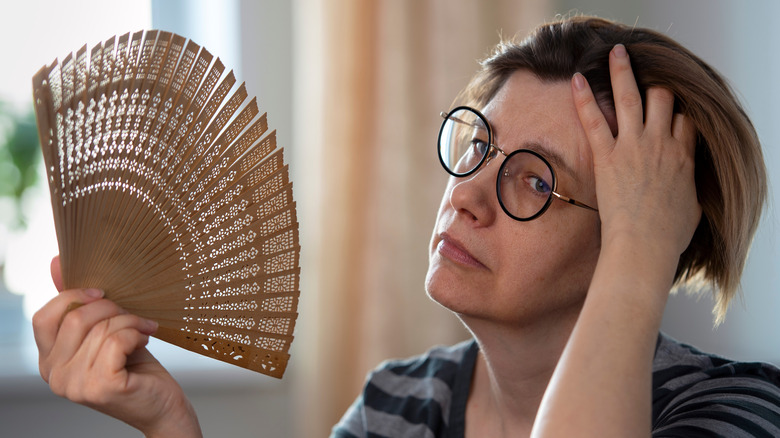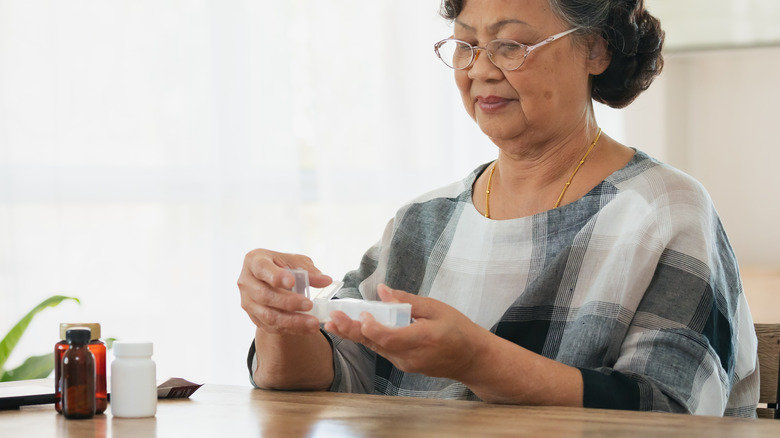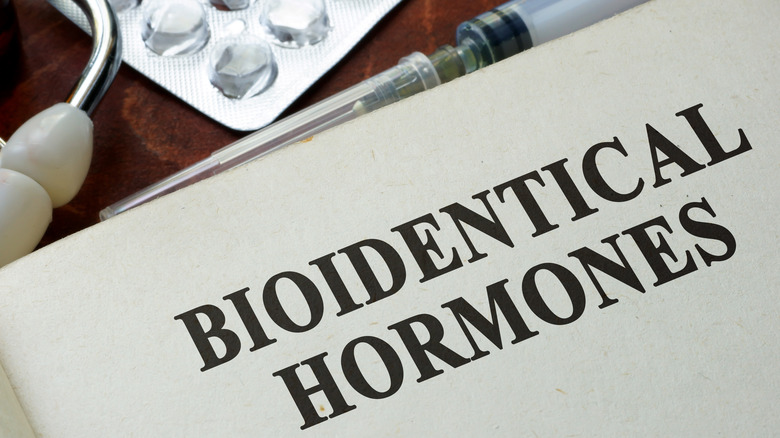Everything You Need To Know About Hormone Replacement Therapy
Hot flashes, night sweats, mood swings, vaginal dryness, and less interest in sex. If you're a woman going through menopause, you're probably experiencing some of the annoying symptoms that tend to go hand in hand with the menopausal transition. Gritting your teeth and trying to tough it out is one approach to getting through the process. But if your symptoms are getting in the way of the activities you enjoy, you may want to consider whether hormone replacement therapy (HRT) could be a safe and effective option for you.
HRT began being used in the 1960s (via Medicina). It was a very popular treatment for menopause symptoms in the 1990s, right up until 2002, when the Women's Health Initiative (WHI) released results of the first clinical trials on the treatment (via the Office on Women's Health). The results showed that HRT had more risks than benefits for menopausal women, including increased instances of blood clots, heart disease, stroke, urinary incontinence, and breast cancer.
In the years since then, the WHI research results have been reevaluated, says Medicina. More recent studies show that HRT can be beneficial in a number of ways. The North American Menopause Society (via breastcancer.org) also updated its position to say that the benefits of HRT in treating menopausal symptoms and preventing bone loss or broken bones may outweigh the risks. However, some healthcare professionals are still wary of prescribing HRT due to the conflicting findings and media coverage over the years (via the Women's Health Network).
The current thinking on the risks and benefits of HRT
Forbes reports that an 18-year follow-up study of the women who participated in the original WHI study revealed some reassuring (or at least clarifying) findings on the risks and benefits of HRT. For starters, it showed that the benefits of HRT usually outweigh the risks for healthy women who are younger than 60 and begin treatment within 10 years of starting menopause. The study (via JAMA) showed that estrogen alone, or estrogen and progestin, used for five to seven years, was not associated with increased risk of cardiovascular or cancer deaths, or any other cause of death, in the following 18 years. In fact, women on HRT had a lower mortality rate than women who didn't take HRT.
JoAnn Manson, a Harvard Medical School professor at Brigham and Women's Hospital and one of the lead researchers on the WHI study, told Forbes that new forms of HRT, such as the patch, are contributing to lower health risks because the estrogen doesn't go through the liver, decreasing the danger of stroke and blood clots. There's also evidence that HRT that begins within five years of menopause may help prevent dementia, while HRT that's started after age 60 may increase the risk of dementia (via Women's Health Concern). HRT can also help fend off heart disease in some age groups, possibly return or maintain an interest in sex, and protect against osteoporosis. The treatment is licensed for use in preventing osteoporosis.
How hormone therapy for transgender individuals is different
Gender-affirming hormone therapy helps transwomen decrease masculine features and develop more feminine features (via the Cleveland Clinic). The treatment may consist of anti-androgen therapy to block testosterone production and decrease masculine features, such as muscle mass and body hair, and estrogen and progesterone to promote feminine characteristics, such as full breasts and more fat on the hips and buttocks.
Hormone therapy also helps transmen suppress menstrual cycles, decrease the production of estrogen, and develop more masculine features, including more muscle mass and body hair, and a deeper voice, says the Mayo Clinic. Along with gender affirmation surgery (per the Cleveland Clinic), hormone therapy is an option for individuals who feel that their physical appearance doesn't match their gender identity.
Transwomen may experience symptoms similar to menopause if their estrogen dose is reduced or stopped, but that's not menopause per se, says Dr. Maria Monge, assistant professor of pediatrics and internal medicine at Dell Medical School, who provides gender-affirming care (via HealthyWomen). Transmen may experience menopausal symptoms when they start taking testosterine, and when they have gender-affirming surgery (such as a hysterectomy).
Menopausal symptoms that hormone replacement therapy can treat
Hot flashes are one of the most well-known symptoms of menopause that HRT can help treat (via MedicineNet). The symptoms can occur anytime during perimenopause, menopause, and postmenopause (via Medical News Today), and are characterized by a feeling of warmth spreading throughout your body and often accompanied by flushed skin and heavy sweating. Hot flashes can last anywhere from 30 seconds to a few minutes, and about 70% of women experience this symptom at some time during their menopausal transition, says MedicineNet.
Night sweats (profuse sweating that can soak clothing and bedding) may also lead you to look into HRT during menopause, says the Cleveland Clinic. And get this: Night sweats can last a few years, or even the rest of your life, although they usually become less severe as time goes by.
Other menopausal symptoms you might experience include vaginal dryness and discomfort, difficulty sleeping, minor memory lapses, feeling moody or depressed, becoming less interested in sex, and gaining weight — especially around your waistline (via WebMD). Whether these symptoms are minor or significant may be one determining factor in whether HRT is right for you, says the Mayo Clinic.
Your doctor may recommend HRT if you have no risk factors for heart disease, blood clots, stroke, or breast cancer; you're willing to accept the small increase of risk for cancer and heart disease; and your menopause symptoms are lowering your quality of life (via Kaiser Permanente).
Types of hormone replacement therapy
There are a number of options when it comes to treating menopausal symptoms with HRT. Your choice will depend on your overall health, the menopausal symptoms you're trying to relieve, and your personal preferences, says WebMD.
Estrogen pills are the most commonly used form of HRT, and the most widely studied. They are usually taken once a day, without food. Skin patches that provide estrogen, or estrogen and progestin, are an easy-to-use form of HRT. The patches are usually applied on your stomach, below your waistline, and the hormones are absorbed through your skin and directly into your bloodstream. You usually change the patches once or twice a week.
Topical gels, sprays, and creams are typically applied once a day, after you bathe or shower, and need to be completely dry before you put on your clothes. Vaginal creams, rings, and suppositories, also called vaginal tablets, are best suited for symptoms specifically in the vaginal area, such as vaginal dryness and painful intercourse. But they won't relieve menopausal symptoms in the rest of your body, such as hot flashes. Dosing varies, but creams are often applied daily, rings need to be replaced every three months, and vaginal tablets can range from daily application to every couple weeks.
There are also estrogen injections, which are injected into a muscle by a healthcare professional. Injections are usually administered every three to four weeks (via MedlinePlus).
One hormone replacement therapy is available without a prescription
While most types of HRT require a prescription, Britain has approved over-the-counter (OTC) access to the low-dose Gina 10 microgram vaginal tablet to treat symptoms of vaginal itching, burning, dryness, soreness, and discomfort during sex (via Women's Health Concern). The tablets, which contain a form of estrogen called estradiol, are scheduled to be available in September 2022.
"Making Gina available over the counter is a huge step forward in enabling women to access HRT as easily as possible, ensuring they can continue living their life as they navigate the menopause," says Maria Caulfield, Minister for Health at Britain's Department for Health and Social Care.
Low-dose vaginal estradiol has been used as a prescribed HRT treatment since 1991, and has a good safety record. As an OTC product, it is dispensed by a pharmacist who has access to training materials and a checklist to help you decide if the treatment is safe for you. Other vaginal tablets continue to be available only with a prescription.
When to avoid hormone replacement therapy
If you have current or past breast or endometrial cancer, uncontrolled high blood pressure, heart or liver disease, abnormal and undiagnosed vaginal bleeding, or you're pregnant or breast-feeding, HRT is probably not a wise choice for you, says Menopause Clinic, London.
High levels of triglycerides (a type of fat) in your blood, thrombosis or blood clots, a family history of gallbladder disease, or a personal history of strokes are other reasons why you and your doctor may decide against HRT to treat your menopausal symptoms (via Medical News Today).
According to Women's Health Network, additional factors you and your doctor will want to consider include your age, weight and body mass index (BMI), alcohol consumption, and environmental stressors — which can include everything from starting a new job or moving to a new home to experiencing an unpredictable natural disaster like a flood or earthquake (via ScienceDirect). All these factors need to be considered when deciding whether HRT is right for you.
Possible side effects of hormone replacement therapy
Side effects of HRT may include depression and mood swings, swelling in your breasts or other parts of your body, breast tenderness, headaches or migraines, indigestion or nausea, leg cramps, bloating, and acne, says Medical News Today. Talk to your doctor if you have worrisome symptoms; it's possible there are alternative treatments that could work better for you, with fewer side effects. Other ways to ease the symptoms include taking the medication with food to avoid indigestion; eating a low-fat, high-carbohydrate diet, which may help with breast tenderness; and stretching and exercising to alleviate leg cramps.
Some women experience weight gain when they first start hormone replacement therapy, due to fluid retention (via Menopause Clinic, London), but their weight tends to stabilize after a while on the treatment. Other side effects usually go away after a few weeks, but some women who have severe symptoms may choose to discontinue treatment or switch to another form of treatment. For example, if you experience severe nausea or migraines with an oral treatment, a patch may work better for you.
Progesterone isn't needed if you've had a hysterectomy
If you've had a hysterectomy and no longer have a uterus, you probably just need to take estrogen, not the combination of estrogen and progesterone (via the Cleveland Clinic). Taking estrogen alone has fewer long-term risks than the combination of hormones.
If you have a uterus, your hormone replacement therapy needs to include both estrogen and progesterone. Here's why: Progesterone is a female hormone that decreases the amount of estrogen in the uterus. While you're still having menstrual periods, you're shedding cells from the lining (endometrium) of your uterus. When your periods stop during menopause, endometrium cells are no longer being shed. As a result, they can build up in your uterus, putting you at risk of endometrial (uterine) cancer. Progesterone keeps the endometrium thin.
Progesterone replaces the natural progesterone that your body stops producing during menopause, says MedlinePlus. This may bring back monthly bleeding, or result in no bleeding at all, says the Cleveland Clinic.
Alternatives to hormone replacement therapy
Numerous studies have been done on treating menopausal symptoms with herbal remedies, such as black cohosh, soy, red clover, and flaxseed (via the National Center for Complementary and Integrative Health). Some of the studies show minimal symptom relief, but not necessarily more than the control groups that were given placebos (inert substances that stimulate healing by convincing your brain that you're receiving an effective treatment, per Harvard Health Publishing). If you want to try herbal remedies, remember that the health benefits and dosages aren't necessarily supported by scientific evidence, and that the quality and purity of the products can't be guaranteed, according to the National Health Service (NHS) in England.
Lifestyle measures such as getting regular exercise, eating a healthy diet, sleeping in a cool, well-ventilated room in loose clothing, and cutting down on your intake of spicy food, caffeine, and alcohol may help relieve menopausal symptoms. It may also help to give up smoking if you smoke, use a vaginal lubricant if you're troubled by vaginal dryness, and reduce your stress levels by practicing tai chi or yoga. Acupuncture also may have benefits, says the International Menopause Society.
What you should know about bioidentical hormone replacement therapy
While most conventional replacement hormones are made from synthetic hormones, bioidentical hormone replacements are made to be exact bio-chemical matches to a woman's naturally produced hormones, says Psychology Today.
One form of bioidentical HRT involves using a woman's saliva to prepare her individual hormone compounds (via Moreland OB-GYN). That form of HRT is not subject to U.S. Food & Drug Administration (FDA) testing, monitoring, and regulation, and the quality of the product is dependent on the quality of the compounding pharmacy. That makes the treatment a bit of a crapshoot.
Other bioidentical hormone therapies are derived from plants, then altered in a lab into a form that people can use. These bioidentical hormones are available in pills, creams, gels, sprays, and patches. They are FDA-approved and are tested for safety, purity, and potency before becoming available for sale.
Hormone pellets are the latest advancement in bioidentical HRT, according to Chapel Hill Gynecology. A healthcare professional implants a pellet under your skin and it consistently releases hormones into your bloodstream for up to five months. The steady release is said to maximize relief from menopausal symptoms.
Yes, Premarin is really made from horses' urine
Premarin (or PMU) is a very common HRT drug that is derived from pregnant mares' urine. In fact, its very name stands for PREgnant MAres uRINe (via ScienceDirect).
This method of HRT production began in the 1940s, when it was discovered that estrogen taken from the urine of pregnant mares could relieve menopausal symptoms in women. The resulting industry spread rapidly throughout the northern United States and Canada, says Horsetalk in New Zealand. Today, more than 9,000,000 women take the drug to relieve menopausal symptoms that include vaginal dryness, hot flashes, and night sweats. Premarin may also prevent osteoporosis.
According to Forum Health, Premarin contains many types of equine estrogens, and only two are bio-identical to human estrogens. The others are much stronger and last longer than human estrogens, and they are suspected of having more side effects in humans.
Not surprisingly, the practice of keeping pregnant mares in small stalls for most of their one-after-another pregnancies, attached to urine bladder bags to collect all their urine, has raised the ire of animal welfare agencies. As a result, most PMU farms are now located in Canada, says Horsetalk, and overseas (via Gentle Giants Draft Horse Rescue).
How to reduce the risks of hormone replacement therapy
One way to reduce the risks of HRT, says the Mayo Clinic, is to take the least amount of hormones you can to effectively treat your menopausal symptoms, and take them for the shortest amount of time.
The North American Menopause Society has a slightly different recommendation after updating its position statement in 2017 (via breastcancer.org). It recommends the appropriate dose, duration, regimen, and route of administration that provides the most benefit with the minimal amount of risk. The organization's point is that every woman is different and treatment should be individualized to maximize benefits and minimize risks.
If your symptoms are mainly vaginal, a vaginal cream, ring, or tablet may be best for you because it delivers treatment directly to the problem area, without affecting your entire body. However, if you are trying to relieve hot flashes and night sweats, you'll probably need an HRT pill or patch to manage your symptoms, says the Mayo Clinic.
How to know when to stop hormone replacement therapy
It may be time to talk to your healthcare professional about quitting HRT if you're around 60, your menopause started about 10 years ago, and you've been on HRT for five or more years (via GoodRx Health). Side effects of quitting HRT that will lessen over time include mood swings, hot flashes, and night sweats. Symptoms are caused by a drop in your estrogen levels.
Mild forms of HRT, such as topical creams, can be stopped immediately, but other forms should be gradually stopped so your menopausal symptoms are less likely to return, says Nature's Best. Options for weaning yourself off HRT include cutting pills in half, using a patch with lowering doses, or decreasing the number of times a week you take your HRT (via Healthgrades). It might take three to six months (or even up to a year) to completely stop HRT, depending on the type of hormone therapy you've been on.
According to ABC News, one out of four women who stops HRT goes back to it when their withdrawal symptoms become severe. Withdrawal may be especially challenging for women who have been on HRT for 10 or more years, but many health professionals agree that tapering HRT gradually gives you the best chance of successfully stopping.














